Trees

American Chestnut 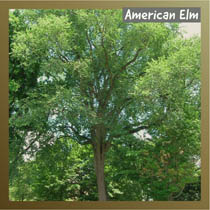
American Elm 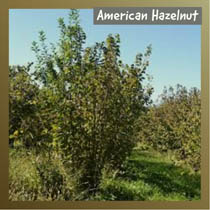
American Hazelnut 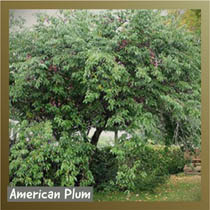
American Plum 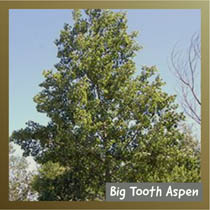
Big Tooth Aspen 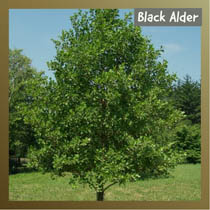
Black Alder 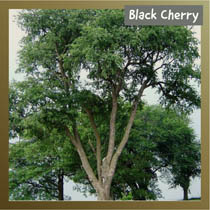
Black Cherry 
Black Chokeberry 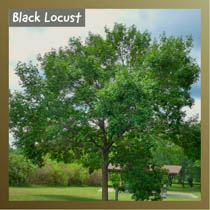
Black Locust 
Black Oak 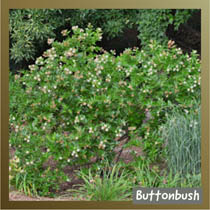
Buttonbush 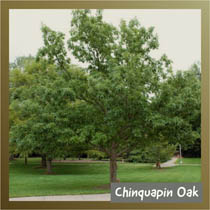
Chinquapin Oak 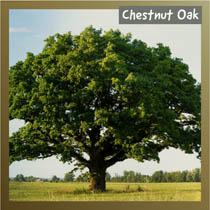
Chestnut Oak 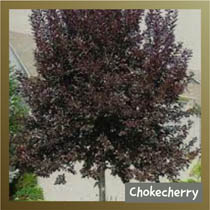
Chokecherry 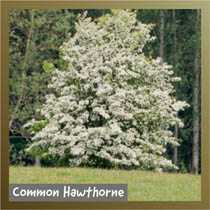
Common Hawthorne 
Eastern Hemlock 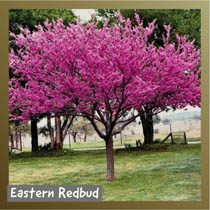
Eastern Redbud 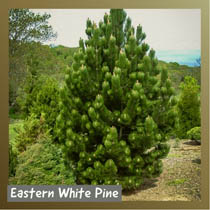
Eastern White Pine 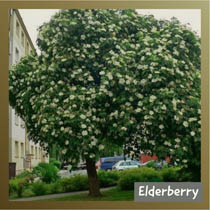
Elderberry 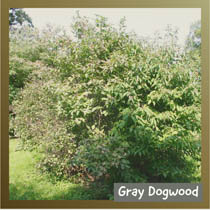
Gray Dogwood 
Highbush Cranberry 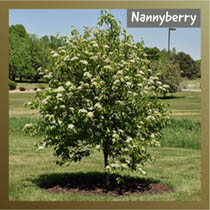
Nannyberry 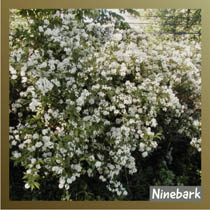
Ninebark 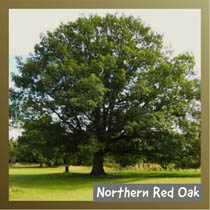
Northern Red Oak 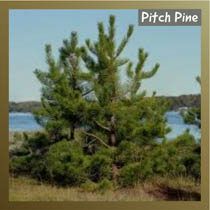
Pitch Pine 
Quaking Aspen 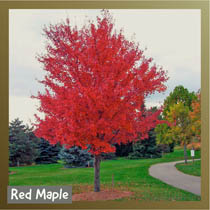
Red Maple 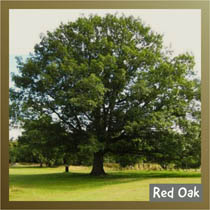
Red Oak 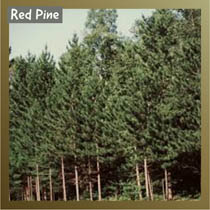
Red Pine 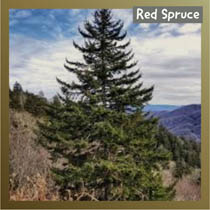
Red Spruce 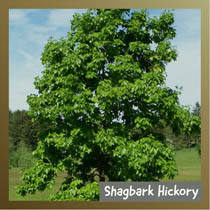
Shagbark Hickory 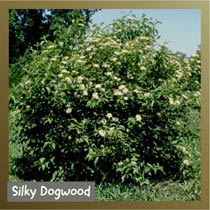
Silky Dogwood 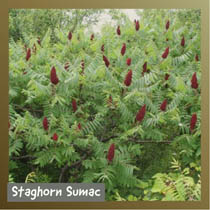
Staghorn Sumac 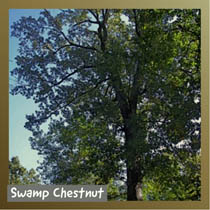
Swamp Chestnut 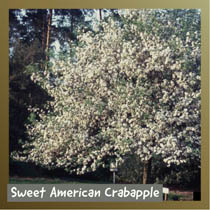
Sweet American Crabapple 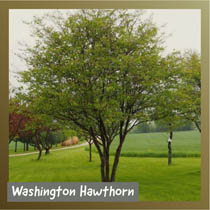
Washington Hawthorn 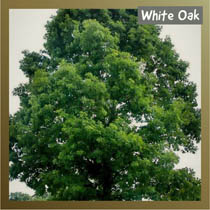
White Oak 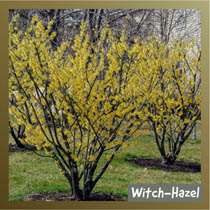
Witch Hazel
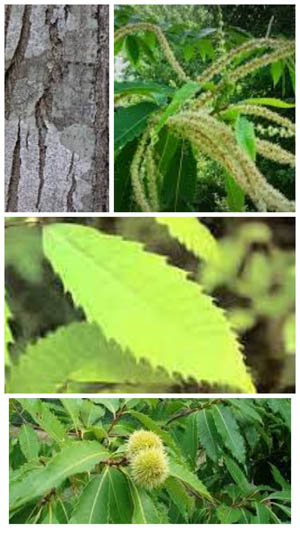
American Chestnut
Castanea dentata
Most chestnut species are tall trees, commonly with furrowed bark when mature. The toothed leaves are lance-shaped to somewhat oval. Most male flowers are borne in long upright catkins; female flowers are arranged singly or in clusters at the base of short male catkins. Anywhere from one to seven nuts are surrounded by a spiny bur, and splits upon reaching maturity. The seeds lose viability rapidly and typically germinate shortly after they fall to the ground in autumn.
Sources:
- The Editors of Encyclopedia Britannica. (n.d.). Chestnut | description, uses, species, & facts. Encyclopedia Britannica. Retrieved April 17, 2021, from https://www.britannica.com/plant/chestnut#ref136656
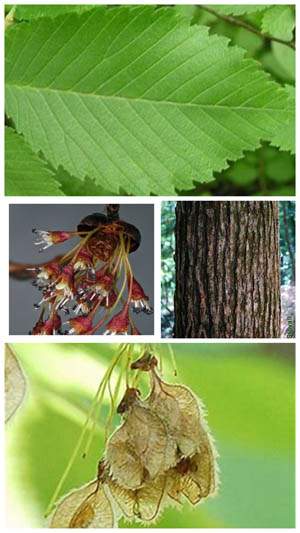
American Elm
Ulmus americana
Elm leaves are doubly toothed and often lopsided at the base. The petal-less flowers appear before the leaves and are borne in clusters on jointed stems. The nutlike fruit, surrounded by a flat, sometimes hairy, winglike structure, is called a samara. The American Elm of eastern North America may grow about 80 to 100 feet tall. It has dark gray, ridged bark, and elliptical leaves.
Sources:
- The Editors of Encyclopedia Britannica. (n.d.-b). Elm | description, uses diseases, & major species. Encyclopedia Britannica. Retrieved April 17, 2021, from https://www.britannica.com/plant/elm-tree#ref341685
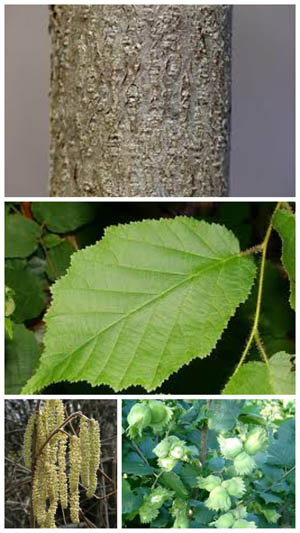
American Hazelnut
Corylus americana
Hazelnuts are deciduous; their leaves are alternate, serrate, obovate, and hairy. The plants range from 10 to 120 feet in height. In late winter, a profusion of yellow male catkins and smaller, red-centered clusters of female flowers appear on the same tree. The roundish or oblong brown nut, usually 0.5 to 1.5 inches long, is partly or wholly enclosed in a husk.
Sources:
- The Editors of Encyclopedia Britannica. (n.d.-c). Hazelnut | description, species, & facts. Encyclopedia Britannica. Retrieved April 17, 2021, from https://www.britannica.com/plant/filbert-tree
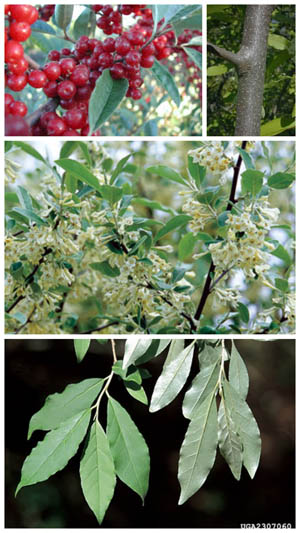
Autumn Olive
Elaeagnus umbellata
Autumn olive is a deciduous shrub that can grow 20 feet tall and 30 feet wide. Its leaves are elliptically shaped and can be distinguished from other similar shrubs by the shimmery look of the silver scales found on its lower leaf surface. Autumn olive's bell-shaped flowers are cream or pale-yellow color and bloom in early spring. They bring on red berries dotted with silver scales, which has led the plant to also be known as silverberry.
Sources:
- Autumn Olive: Your Invasive, Seedy Neighbor. (2020, July 30). The Nature Conservancy. https://www.nature.org/en-us/about-us/where-we-work/united-states/indiana/stories-in-indiana/autum-nolive/#:%7E:text=Autumn%20olive%20%28Elaeagnus%20umbellata%29 %20is%20a%20deciduous%20shrubas%20erosion%20control%20near%20roads%20and%20on%20ridges
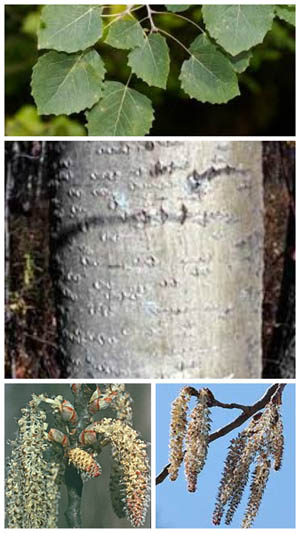
Big Tooth Aspen
Populus grandidentata
Bigtooth Aspens have oval leaves that are simple and alternate, with a short-pointed tip, large, rounded, irregular teeth, and a rounded base. When they first open in the spring, they are covered by dense whitish hairs, so the trees are very easy to identify. Young Bigtooth Aspen trees have light, smooth bark, tan to yellowish or greenish-gray. The bark often has an orange cast. The bark of a mature Bigtooth Aspen is darker and furrowed, often showing an orangish inner bar. As the tree ages, the bark darkens further, and the furrows deepen.
Native to the Northern Hemisphere, they are known for the fluttering of leaves in the slightest breeze. All aspens display a smooth, gray-green bark, random branching, rich green leaves that turn brilliant yellow in fall, and catkins (male and female on separate trees) that appear before the leaves in spring. The trees can reach a height of 80 feet.
Native to the Northern Hemisphere, they are known for the fluttering of leaves in the slightest breeze. All aspens display a smooth, gray-green bark, random branching, rich green leaves that turn brilliant yellow in fall, and catkins (male and female on separate trees) that appear before the leaves in spring. The trees can reach a height of 80 feet.
Sources:
- The Editors of Encyclopaedia Britannica. (n.d.-a). Aspen | plant. Encyclopedia Britannica. Retrieved April 17, 2021, from https://www.britannica.com/plant/aspen-plant
- Trees of the Adirondacks: Bigtooth Aspen| Populus grandidentata. (n.d.). Adirondacks Forever Wild. Retrieved April 21, 2021, from https://wildadirondacks.org/trees-of-the-adirondacks-bigtooth-aspen-populus-grandidentata.html

Black Alder
Alnus glutinosa
The European alder, sometimes known as black alder for its dark bark and cones, is widespread throughout North America. The scaly bark is grayish-brown in some species and almost white in others. The oval leaves are alternate, serrate, and often shallowly lobed; leaves are sticky on unfolding but glossy when mature, they fall without changing color. Male and female flowers are born in separate catkins on the same tree; they form during the summer and usually blossom the following spring before the leaves open.
Sources:
- The Editors of Encyclopaedia Britannica. (n.d.-a). Alder | definition, description, tree, wood, & facts. Encyclopedia Britannica. Retrieved April 17, 2021, from https://www.britannica.com/plant/alder#ref347286
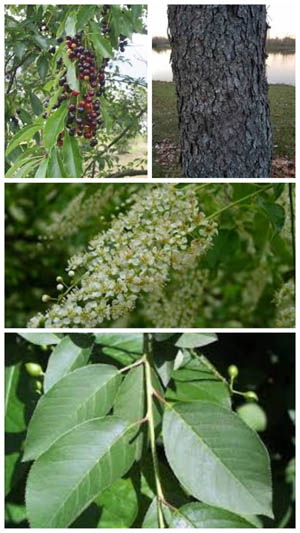
Black Cherry
Prunus serotina
The leaves of the Black Cherry are oblong, with a long-pointed tip and a tapering base. The leaves, like the branches, are alternate: they emerge from the stem one at a time. The edges of each leaf are finely toothed, the tiny teeth curve inward. In the spring, the leaves have a pair of brightly colored stipules (outgrowths on either side of the leaf stalk). Black Cherry leaves are shiny and dark green on the upper surface, light green below. The emerging leaves of the Black Cherry are often reddish. In fall, the leaves turn yellow to orange, then to red late in the season.
Black Cherry bark is reddish-brown and smooth when young, with conspicuous, horizontal gray lines. The inner bark has a bitter almond smell. As the trees mature, the bark breaks into scales that are curled outward. If you break off one of the scales, you will find a bright orange-brown underbark. The bark of an older Black Cherry consists of layers of reddish-brown or black scales with upturned edges. The bark of a mature Black Cherry tree is said to resemble burnt corn flakes, providing a handy memory device: Black Cherry/Burnt Cornflakes.
Black cherry trees display rapid growth, up to 50 - 80' tall and 30' - 60' wide. The fruits are important for many birds such as wrens, mockingbirds, thrashers, waxwings, and woodpeckers, and small and large mammals. A total of 456 moth and butterfly species are supported by Black cherry trees.
Black Cherry bark is reddish-brown and smooth when young, with conspicuous, horizontal gray lines. The inner bark has a bitter almond smell. As the trees mature, the bark breaks into scales that are curled outward. If you break off one of the scales, you will find a bright orange-brown underbark. The bark of an older Black Cherry consists of layers of reddish-brown or black scales with upturned edges. The bark of a mature Black Cherry tree is said to resemble burnt corn flakes, providing a handy memory device: Black Cherry/Burnt Cornflakes.
Black cherry trees display rapid growth, up to 50 - 80' tall and 30' - 60' wide. The fruits are important for many birds such as wrens, mockingbirds, thrashers, waxwings, and woodpeckers, and small and large mammals. A total of 456 moth and butterfly species are supported by Black cherry trees.
Sources:
- List of Western PA Natives | Audubon Society of Western PA. (n.d.). Audubon Society of Western Pennsylvania. Retrieved April 21, 2021, from http://www.aswp.org/pages/list-natives
- Trees of the Adirondacks: Black Cherry | Prunus serotina. (n.d.). Adirondacks Forever Wild. Retrieved April 21, 2021, from https://wildadirondacks.org/trees-of-the-adirondacks-black-cherry-prunus-serotina.html
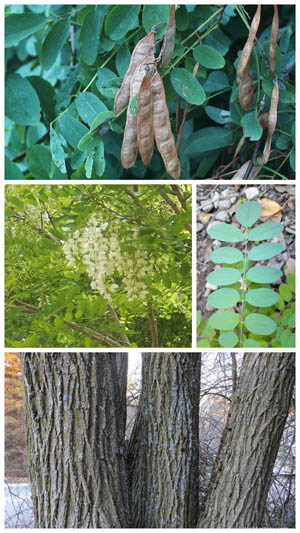
Black Locust
Robinia pseudoacacia
Black Locust trees usually grow to between 40 to 100 feet high. These trees have a narrow crown that tends to become bushy as the tree ages. The leaves of the tree are usually dark bluish-green with a lighter underside.
Black locust trees need plenty of sunlight to grow and do not tolerate shade well. They are often thought of as weed trees because they frequently grow in areas that have been disturbed or cleared, where sunlight is plentiful between gaps in other congregations of trees. Black locusts frequently spread through underground shoots as well. Frequently the trees have spines when they are young, losing the spines as they mature.
The flowers appear in large dense clusters on the tree. The flowers are between 4 to 8 inches in length and are known for their powerful fragrance. While the flowers are normally white, some varieties of black locusts have purple or pink flowers. The flowers hang down from the branches of the tree and they often provide nectar for honeybees. In return, these honeybees pollinate the plant.
The bark is usually gray and black with a red or orange tinge to it. The bark has many ridges and grooves that frequently form diamond patterns along the trunk of the tree.
Black locust trees need plenty of sunlight to grow and do not tolerate shade well. They are often thought of as weed trees because they frequently grow in areas that have been disturbed or cleared, where sunlight is plentiful between gaps in other congregations of trees. Black locusts frequently spread through underground shoots as well. Frequently the trees have spines when they are young, losing the spines as they mature.
The flowers appear in large dense clusters on the tree. The flowers are between 4 to 8 inches in length and are known for their powerful fragrance. While the flowers are normally white, some varieties of black locusts have purple or pink flowers. The flowers hang down from the branches of the tree and they often provide nectar for honeybees. In return, these honeybees pollinate the plant.
The bark is usually gray and black with a red or orange tinge to it. The bark has many ridges and grooves that frequently form diamond patterns along the trunk of the tree.
Sources:
- Nelson, D. (2019, November 2). Black Locust Tree: Types and Pictures. Science Trends. https://sciencetrends.com/black-locust-tree-types-and-pictures/
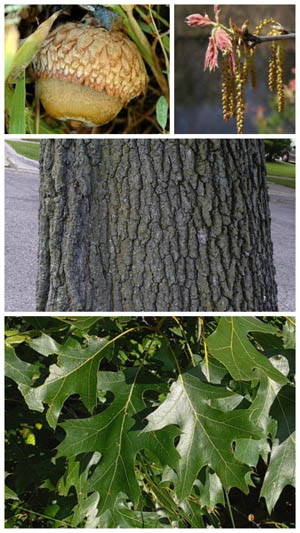
Black Oak
Quercus velutina
Black oak is a North American timber tree distributed throughout the eastern United States. It usually grows to about 80 feet tall and may grow to 135 ft. on rich soils; it is common on exposed slopes and ridges, as it cannot tolerate shade. The tree's blackish outer bark is ridged in irregular blocks; the orange-yellow inner bark is a source of tannin and quercitron, a yellow dye. The leaf buds are sharply pointed and covered with down. The leaves are usually seven-lobed. Acorns provide food for a variety of birds and mammals and cavities provide a den, nesting, and roosting sites for birds. A total of 534 moth and butterfly species are supported by oaks.
Sources:
- List of Western PA Natives | Audubon Society of Western PA. (n.d.). Audubon Society of Western Pennsylvania. Retrieved April 21, 2021, from http://www.aswp.org/pages/list-natives
- The Editors of Encyclopaedia Britannica. (n.d.-c). Black oak | plant. Encyclopedia Britannica. Retrieved April 21, 2021, from https://www.britannica.com/plant/black-oak
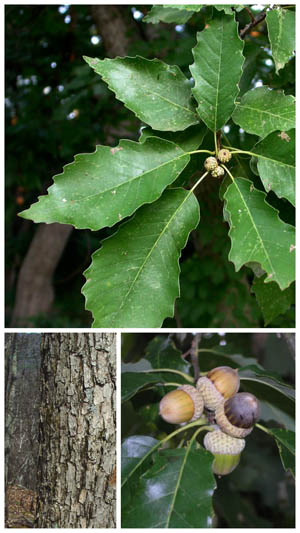
Chinquapin Oak
Quercus muehlenbergii
A medium to large size oak with 4"-6 1/2" glistening dark green leaves in summer turning yellow-orange to orangish-brown in fall. Produces 1" sweet acorns that mature in a single season. The acorns are at the top of the food preference list for many wildlife species. The bark is an ashy light gray that breaks into narrow, thin flakes. As this species matures, it becomes a magnificent specimen and a conversation piece. Grows 40'-50' high with a similar spread under landscaping conditions, becoming 70'-80' high in the wild. Does best in well-drained soil and adapts to many different soil types. Grow in full sun.
Chinquapin oak acorns are the preferred food for wild turkeys, grouse, white-tailed deer, black bears, chipmunks, squirrels, and hogs. Cattle will eat the leaves.
The chinquapin oak is also commonly referred to as yellow chestnut oak, rock oak, or yellow oak. Early pioneers used its straight wood to make thousands of miles of fences in the states of Ohio, Kentucky, and Indiana. Later on, the trees were used to fuel the steamships that ran from Pittsburgh to New Orleans. They were also used as railroad ties for the new railroads that crisscrossed the Midwest.
Chinquapin oak acorns are the preferred food for wild turkeys, grouse, white-tailed deer, black bears, chipmunks, squirrels, and hogs. Cattle will eat the leaves.
The chinquapin oak is also commonly referred to as yellow chestnut oak, rock oak, or yellow oak. Early pioneers used its straight wood to make thousands of miles of fences in the states of Ohio, Kentucky, and Indiana. Later on, the trees were used to fuel the steamships that ran from Pittsburgh to New Orleans. They were also used as railroad ties for the new railroads that crisscrossed the Midwest.
Sources:
- Chinquapin Oak Tree on the Tree Guide at arborday.org. (n.d.). Arbor Day Foundation. Retrieved April 21, 2021, from https://www.arborday.org/trees/treeGuide/treedetail.cfm?itemID=875
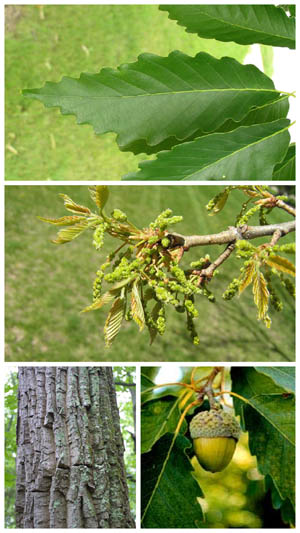
Chestnut Oak
Quercus prinus
Chestnut oak, also called rock chestnut oak, is a tree found on rocky soils of the eastern United States and southern Canada. It is usually about 70 feet tall but may grow to 90 ft. It has blackish, tannin-rich bark, with deep longitudinal ridges; the chestnut-like, lance-shaped leaves are approximately 7 inches long.
Sources:
- The Editors of Encyclopaedia Britannica. (n.d.-d). Chestnut oak | plant. Encyclopedia Britannica. Retrieved April 21, 2021, from https://www.britannica.com/plant/chestnut-oak

Chinkapin Oak
Quercus muehlenbergii
A medium to large size oak with 4"-6 1/2" glistening dark green leaves in summer turning yellow-orange to orangish-brown in fall. Produces 1" sweet acorns that mature in a single season. The acorns are at the top of the food preference list for many wildlife species. The bark is an ashy light gray that breaks into narrow, thin flakes. As this species matures, it becomes a magnificent specimen and a conversation piece. Grows 40'-50' high with a similar spread under landscaping conditions, becoming 70'-80' high in the wild. Does best in well-drained soil and adapts to many different soil types. Grow in full sun.
Chinkapin oak acorns are the preferred food for wild turkeys, grouse, white-tailed deer, black bears, chipmunks, squirrels, and hogs. Cattle will eat the leaves.
The chinkapin oak is also commonly referred to as yellow chestnut oak, rock oak, or yellow oak. Early pioneers used its straight wood to make thousands of miles of fences in the states of Ohio, Kentucky, and Indiana. Later on, the trees were used to fuel the steamships that ran from Pittsburgh to New Orleans. They were also used as railroad ties for the new railroads that crisscrossed the Midwest.
Chinkapin oak acorns are the preferred food for wild turkeys, grouse, white-tailed deer, black bears, chipmunks, squirrels, and hogs. Cattle will eat the leaves.
The chinkapin oak is also commonly referred to as yellow chestnut oak, rock oak, or yellow oak. Early pioneers used its straight wood to make thousands of miles of fences in the states of Ohio, Kentucky, and Indiana. Later on, the trees were used to fuel the steamships that ran from Pittsburgh to New Orleans. They were also used as railroad ties for the new railroads that crisscrossed the Midwest.
Sources:
- Chinkapin Oak Tree on the Tree Guide at arborday.org. (n.d.). Arbor Day Foundation. Retrieved April 21, 2021, from https://www.arborday.org/trees/treeGuide/treedetail.cfm?itemID=875
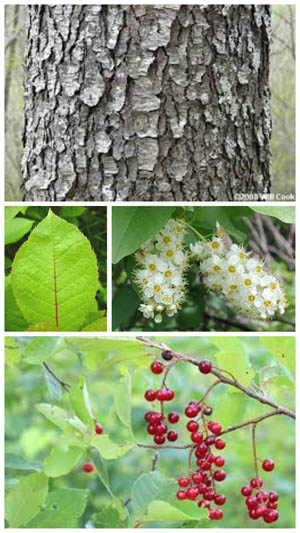
Chokecherry
Prunus virginiana
Chokecherry is a deciduous shrub or small tree native to North America. It is named for the astringent, acidic taste of its reddish cherries, which may be made into jelly and preserves. The stones and foliage are poisonous. Chokecherries often form dense thickets on moist soils and are frequently attacked and defoliated by eastern tent caterpillars. The plant grows to a height of 20 feet, producing hanging spikes of disagreeably scented white flowers. The slender brown twigs also have an unpleasant odor and a bitter taste. The bark is brown or gray, smooth on new growth but becoming scaly with age.
Sources:
- The Editors of Encyclopaedia Britannica. (n.d.-d). Chokecherry | plant. Encyclopedia Britannica. Retrieved April 17, 2021, from https://www.britannica.com/plant/chokecherry
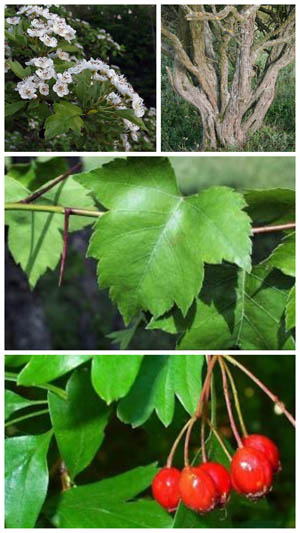
Common Hawthorne
Crataegus monogyna
The Common Hawthorn typically grows 10 to 20' in height. There is a main trunk that on average, at maturity, can reach between 15 and 20 cm (about 8") in diameter. Hawthorn bark is gray with shallow, longitudinal fissures with narrow ridges. In younger trees, the bark is smooth and gray, as seen on a branch of the hawthorn. As they age, the bark darkens into a shade of brown and develops fissures and ridges.
Hawthorns have thorny branches. The thorns are smaller branches that arise from a larger branch and are typically 1 to 3 cm long. These thorns tend to be sharp. This deciduous tree has alternate branching, in which the twigs (or thorns) are not directly opposite each other.
Leaves are stalked, broadly ovate, and pinnately lobed. The lobes are rounded, with entire margins but toothed at the tip; veins are fine-hairy. Its blade is dull on top, and bluish green beneath. Flowers measure about 0.4" across. It has 5 calyx-lobes, is broadly triangular, blunt, recurved, and fine-hairy. This white flower has 20 stamens and one carpel. Bloom time is typically in June. Flowers produce an egg-shaped, red drupe. The fruits are rounded, oblong, or pear-shaped, relatively small (the size of a large, cultivated blueberry), and depending on the species, they range from orange-yellow, scarlet, red, yellow, blue, or black.
Hawthorns have thorny branches. The thorns are smaller branches that arise from a larger branch and are typically 1 to 3 cm long. These thorns tend to be sharp. This deciduous tree has alternate branching, in which the twigs (or thorns) are not directly opposite each other.
Leaves are stalked, broadly ovate, and pinnately lobed. The lobes are rounded, with entire margins but toothed at the tip; veins are fine-hairy. Its blade is dull on top, and bluish green beneath. Flowers measure about 0.4" across. It has 5 calyx-lobes, is broadly triangular, blunt, recurved, and fine-hairy. This white flower has 20 stamens and one carpel. Bloom time is typically in June. Flowers produce an egg-shaped, red drupe. The fruits are rounded, oblong, or pear-shaped, relatively small (the size of a large, cultivated blueberry), and depending on the species, they range from orange-yellow, scarlet, red, yellow, blue, or black.
Sources:
- Common Hawthorn: Identification, Leaves, Bark & Habitat | Crataegus monogyna. (n.d.). Edible Wild Food. Retrieved April 21, 2021, from https://www.ediblewildfood.com/common-hawthorn.aspx
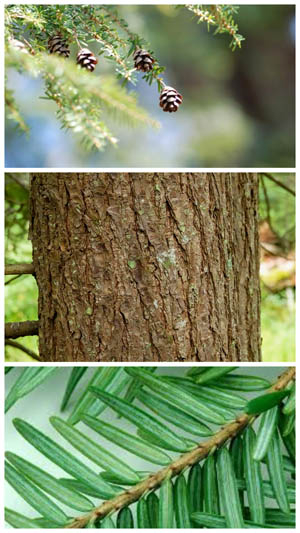
Eastern Hemlock
Tsuga canadensis
Eastern Hemlock is an evergreen tree that flourishes in moist soil. This species is a slow-growing, long-lived tree that may take 250 to 300 years to reach maturity. This tree may reach diameters of four feet and ages of 400 years.
This tree is also known as the Canada Hemlock or Hemlock Spruce. It is a member of the pine family. The common name "hemlock" was reportedly given because the crushed foliage smells a little like that of the poisonous herb hemlock, which is native to Europe.
The Eastern Hemlock has a loose, irregular, feathery silhouette, with fine, lacy twigs whose tips tend to droop gracefully. The root system of this species is shallow, making the tree vulnerable to ground fires, drought, and wind.
This tree has short, flat, blunt, flexible needles, about 1/2 inch long. The needles are rounded at the tip, dark green above and pale silvery below. The needles have rows of tiny teeth on the margins and appear to grow in flat sprays on the lower limbs of trees. The needles are attached to the twig by tiny slender stalks. The light green cones gradually turn into brown cones (about ¾ inch long) and remain soft and flexible until the seeds are released in the fall. The drooping cones persist through winter.
As with many trees, the bark of Eastern Hemlocks changes as the tree matures. When the tree is young, the bark is gray-brown and relatively smooth. As the tree ages, the bark becomes cinnamon brown, with thick, ridges forming flat plates.
This tree is also known as the Canada Hemlock or Hemlock Spruce. It is a member of the pine family. The common name "hemlock" was reportedly given because the crushed foliage smells a little like that of the poisonous herb hemlock, which is native to Europe.
The Eastern Hemlock has a loose, irregular, feathery silhouette, with fine, lacy twigs whose tips tend to droop gracefully. The root system of this species is shallow, making the tree vulnerable to ground fires, drought, and wind.
This tree has short, flat, blunt, flexible needles, about 1/2 inch long. The needles are rounded at the tip, dark green above and pale silvery below. The needles have rows of tiny teeth on the margins and appear to grow in flat sprays on the lower limbs of trees. The needles are attached to the twig by tiny slender stalks. The light green cones gradually turn into brown cones (about ¾ inch long) and remain soft and flexible until the seeds are released in the fall. The drooping cones persist through winter.
As with many trees, the bark of Eastern Hemlocks changes as the tree matures. When the tree is young, the bark is gray-brown and relatively smooth. As the tree ages, the bark becomes cinnamon brown, with thick, ridges forming flat plates.
Sources:
- Eastern Hemlock | Tsuga canadensis. (n.d.). Adirondacks Forever Wild. Retrieved April 21, 2021, from https://wildadirondacks.org/trees-of-the-adirondacks-eastern-hemlock-tsuga-canadensis.html
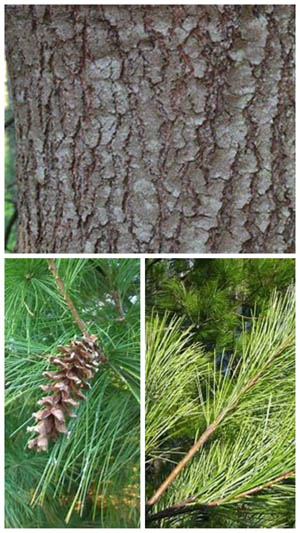
Eastern White Pine
Pinus strobus
The Eastern White Pine is an evergreen tree with fine-textured, long, soft needles. In the correct conditions, it can grow to a height of 90' and a width of 40'. Eastern White Pines provide food and shelter for birds and small mammals.
Sources:
- List of Western PA Natives | Audubon Society of Western PA. (n.d.). Audubon Society of Western Pennsylvania. Retrieved April 21, 2021, from http://www.aswp.org/pages/list-natives

Elderberry
Sambuca candensis
Elderberry is a deciduous, fast-growing, suckering shrub. Flat-topped, creamy white flower clusters bloom in early summer followed by edible, deep purple berries. Elderberries can grow to a height of 5-12' and can spread to 12' or more. Elderberry flowers provide nectar and birds love the fruit.
Sources:
- List of Western PA Natives | Audubon Society of Western PA. (n.d.). Audubon Society of Western Pennsylvania. Retrieved April 21, 2021, from http://www.aswp.org/pages/list-natives
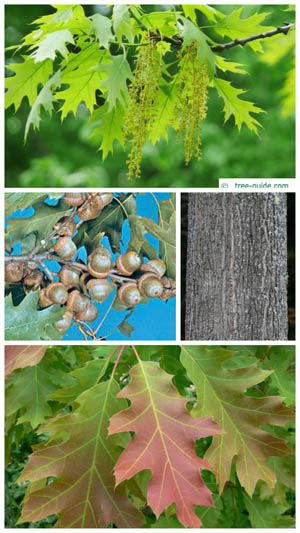
Northern Red Oak
Quercus rubra
Northern Red Oaks grow as much as two feet a year for 10 years, reaching a height of 60–75' and a spread of around 45' at maturity. The tree features alternating leaves that are 4–8" long and have 7–11 waxy, spine-tipped lobes. These bristle-tipped leaves turn red in the fall. Northern Red Oaks yield acorns that are round and 3/4–1" long with a flat, thick, saucer-like cap. Acorns from this tree are at the top of the food preference list for blue jays, wild turkeys, squirrels, small rodents, whitetail deer, raccoons, and black bears. Deer also browse the buds and twigs in wintertime.
Sources:
- Northern Red Oak Tree on the Tree Guide at arborday.org. (n.d.). Arbor Day Foundation. Retrieved April 21, 2021, from https://www.arborday.org/trees/treeGuide/TreeDetail.cfm?itemID=877
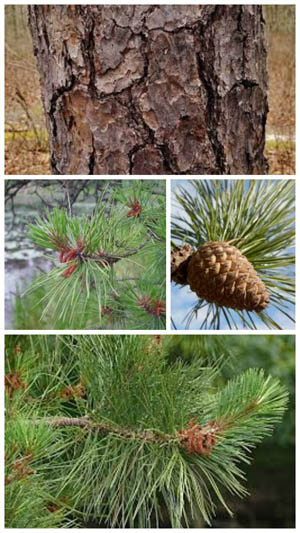
Pitch Pine
Pinus rigida
Pitch pine is a native tree seen throughout the Northeast United States and Eastern Canada. On average it reaches thirty to forty feet in height, but it can grow to almost a hundred feet in ideal conditions. Pitch pines can live to be over two hundred years old and tend to achieve their maximum height after ninety years.
The pitch pine tends to regenerate growth after damage (cutting or burning) and will sprout twisting branches that may curve in different directions. This tendency can create an unusual, somewhat "open" shape and makes the pitch pine a sought-after species for bonsai enthusiasts. It has a rich dark green color to its needles; new growth is yellowish-green and easily recognizable.
The tree produces small cones, about two inches long, that take two years to mature and grow in clusters of three to five. Unlike many pines, the cones on pitch pines tend to remain on the tree for several years, instead of falling. As pitch pines grow older, they tend to take on interesting shapes, as branches regenerate in response to wind or other weather damage.
The pitch pine tends to regenerate growth after damage (cutting or burning) and will sprout twisting branches that may curve in different directions. This tendency can create an unusual, somewhat "open" shape and makes the pitch pine a sought-after species for bonsai enthusiasts. It has a rich dark green color to its needles; new growth is yellowish-green and easily recognizable.
The tree produces small cones, about two inches long, that take two years to mature and grow in clusters of three to five. Unlike many pines, the cones on pitch pines tend to remain on the tree for several years, instead of falling. As pitch pines grow older, they tend to take on interesting shapes, as branches regenerate in response to wind or other weather damage.
Sources:
- Aloi, P. (2021, January 5). Pitch Pine Plant Profile. The Spruce. https://www.thespruce.com/pitch-pine-plant-profile-4847062
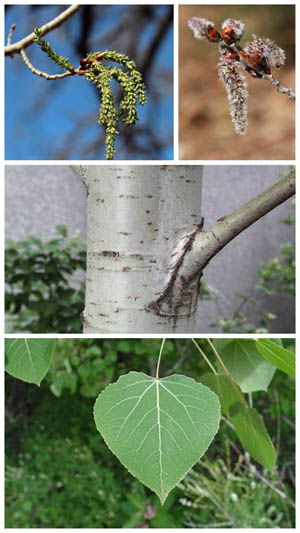
Quaking Aspen
Populus tremuloides
Aspens are native to the Northern Hemisphere and are known for the fluttering of leaves in the slightest breeze. Aspens grow farther north and higher up the mountains than other Populus species. All aspens display a smooth, gray-green bark, random branching, rich green leaves that turn brilliant yellow in fall, and catkins (male and female on separate trees) that appear before the leaves in spring. The American quaking, or trembling, aspen, reaches a height of 80 feet.
Sources:
- The Editors of Encyclopaedia Britannica. (n.d.-a). Aspen | plant. Encyclopedia Britannica. Retrieved April 17, 2021, from https://www.britannica.com/plant/aspen-plant
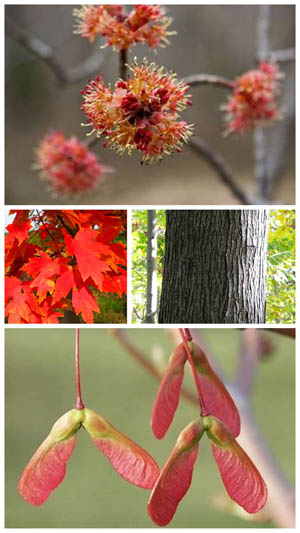
Red Maple
Acer rubrum
Red maple, also called swamp maple, or scarlet maple, is a large, irregularly narrow tree of the soapberry family that is cultivated for its shade and spectacular autumn color. It is one of the most common trees in its native eastern North America. The red maple grows to a height of 90 feet or more on a straight trunk; the crown bears upright or spreading branches that become reddish-brown with age. Young bark is smooth and gray, gradually becoming ridged, scaly, and dark. These trees provide cover and cavities for birds such as Screech Owl, Pileated Woodpecker, and Northern Flicker. A total of 285 moth and butterfly species are supported by maples. Red maples can survive in a variety of conditions but prefer well-drained, moist, slightly acidic soil.
Sources:
- List of Western PA Natives | Audubon Society of Western PA. (n.d.). Audubon Society of Western Pennsylvania. Retrieved April 21, 2021, from http://www.aswp.org/pages/list-natives
- The Editors of Encyclopaedia Britannica. (n.d.-d). Red maple | plant. Encyclopedia Britannica. Retrieved April 17, 2021, from https://www.britannica.com/plant/red-maple
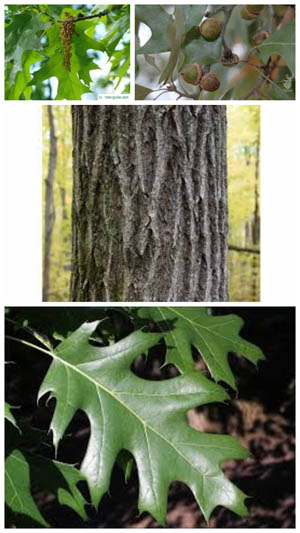
Red Oak
Quercus rubra
Red oaks have exceptional wildlife value. With a height of 50'-75' and width of 50'-75', red oaks are sizeable. The acorns these trees produce provide food for a variety of birds and mammals and cavities provide a den, nesting, and roosting sites for birds. A total of 534 moth and butterfly species are supported by oaks.
Sources:
- List of Western PA Natives | Audubon Society of Western PA. (n.d.). Audubon Society of Western Pennsylvania. Retrieved April 21, 2021, from http://www.aswp.org/pages/list-natives
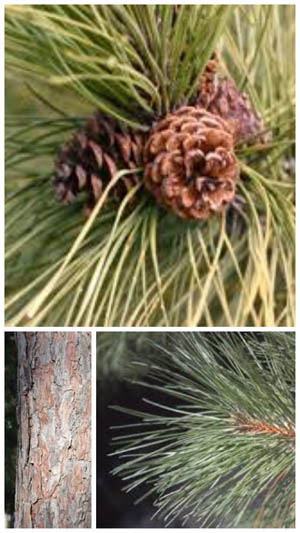
Red Pine
Pinus resinosa
Red pine is a long-lived (200-400 years), coniferous tree. It grows in pure, even-aged stands and uneven-aged mixed stands primarily with eastern white pine, jack pine, and/or quaking aspen. Red pine has an average height of 75 feet, but under ideal conditions may grow as tall as 200 feet. It has a straight trunk with little taper with few branches occurring below the canopy. The bark is furrowed and cross-checked into irregular rectangular, scaly plates up to 2 inches thick.
Red pine has 2 straight to slightly twisted, flexible, slender, sharp-pointed needles, measuring 4 to 6.7 inches long. Most red pine needles live for 3 years, but some may persist for as long as 6 years. Red pine cones are produced near the tips of twigs and are approximately 1.4 to 3 inches long. The middle third of the crown produces the greatest number and heaviest cones. The cones contain ovoid seeds 3 to 5 mm across.
Red pine has a dense and symmetrical crown and upcurved branches with stout twigs up to 0.4 inches thick. One whorl of branches is produced annually from lateral buds formed at the leading shoot. As red pine ages, branch extension and height growth diminish.
Red pine has 2 straight to slightly twisted, flexible, slender, sharp-pointed needles, measuring 4 to 6.7 inches long. Most red pine needles live for 3 years, but some may persist for as long as 6 years. Red pine cones are produced near the tips of twigs and are approximately 1.4 to 3 inches long. The middle third of the crown produces the greatest number and heaviest cones. The cones contain ovoid seeds 3 to 5 mm across.
Red pine has a dense and symmetrical crown and upcurved branches with stout twigs up to 0.4 inches thick. One whorl of branches is produced annually from lateral buds formed at the leading shoot. As red pine ages, branch extension and height growth diminish.
Sources:
- Hauser, S. A. (n.d.). Pinus resinosa. U.S. Department of Agriculture. Retrieved April 21, 2021, from https://www.fs.fed.us/database/feis/plants/tree/pinres/all.html
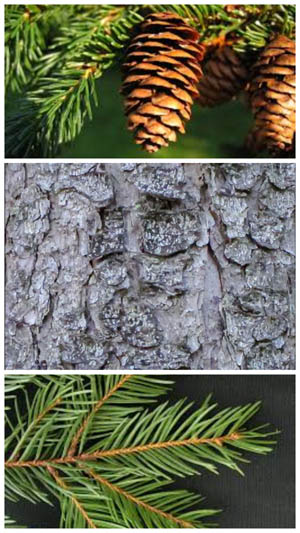
Red Spruce
Picea Ruben
Red Spruce trees have four-sided, short, yellowish-green needles on woody pegs that grow individually on the twig. The cones, which fall soon after maturity, are around 1 1/2 inches long. They hang like pendants and are reddish-brown and woody. The bark of Red Spruce trees is gray-brown to reddish-brown.
This species flowers in May. The pendant male flowers are bright red, while the female flowers are erect and bright green tinged with purple. This tree is rather open-branched, with up-curved tips.
Red Spruce provides food and cover for various mammals and birds. Habitats which include Red Spruce are particularly important as winter cover for White-tailed Deer. Red Squirrels eat buds and seeds. Mice and voles consume and store significant amounts of spruce seeds. North American Porcupines feed on the bark in winter.
This species flowers in May. The pendant male flowers are bright red, while the female flowers are erect and bright green tinged with purple. This tree is rather open-branched, with up-curved tips.
Red Spruce provides food and cover for various mammals and birds. Habitats which include Red Spruce are particularly important as winter cover for White-tailed Deer. Red Squirrels eat buds and seeds. Mice and voles consume and store significant amounts of spruce seeds. North American Porcupines feed on the bark in winter.
Sources:
- Red Spruce | Picea rubens. (n.d.). Adirondacks Forever Wild. Retrieved April 21, 2021, from https://wildadirondacks.org/trees-of-the-adirondacks-red-spruce-picea-rubens.html#:%7E:text=1%20The%20needles%20of%20Red%20Spruce%20are%20yellowish,tends%20to%20be%20more%20open-branched%20than%20White%20Spruce.

Shagbark Hickory
Carya ovata
Shagbark hickory is a medium to large tree that blooms yellow-green in spring and produces edible nuts and gold leaves in fall. It has a distinctive, peeling, gray bark. The trunk is typically narrow and straight with branching that begins halfway up. Shagbark hickory can reach a height of 70' and a width of 35'.
Sources:
- List of Western PA Natives | Audubon Society of Western PA. (n.d.). Audubon Society of Western Pennsylvania. Retrieved April 21, 2021, from http://www.aswp.org/pages/list-natives
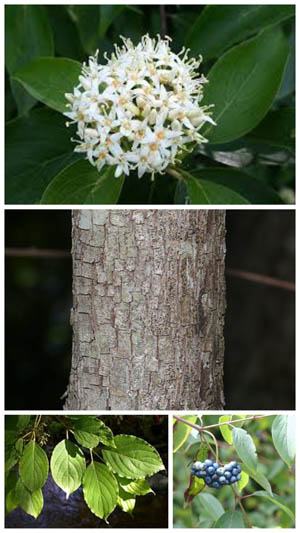
Silky Dogwood
Cornus amomum
Silky Dogwood is a deciduous, suckering shrub that blooms creamy white blossoms in flat-topped clusters in spring and produces bright blue berries in late summer. Foliage turns deep red in fall. Silky dogwoods reach a height anywhere from 3-10'. These trees form colonies and may be aggressive. Dense stands provide cover and food for birds and other wildlife.
Sources:
- List of Western PA Natives | Audubon Society of Western PA. (n.d.). Audubon Society of Western Pennsylvania. Retrieved April 21, 2021, from http://www.aswp.org/pages/list-natives
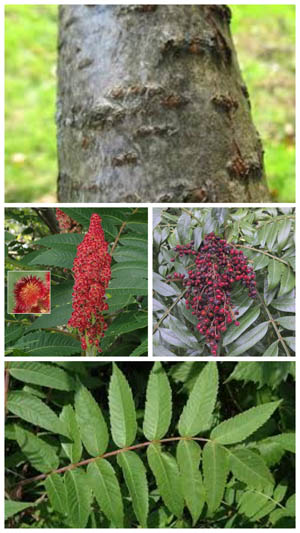
Staghorn Sumac
Rhus typhina
Staghorn Sumacs grow 3 to 33 feet tall, appearing usually tree-like, but in thickets. The stem may reach 10 inches in diameter. Twigs are stout, densely red, hairy, and 5/8 to 3/4 inches thick. Leaves are alternate and pinnately compound, 6 to 16 inches long by 4 to 7 inches wide. Each leaf has 11 to 31 coarsely toothed leaflets, green on top, and much paler underneath. Flowers are born in clusters of hundreds to thousands of flowers at the tips of branches. Flower clusters are up to 8 inches long and 2 to 4 inches across. The yellow to greenish, 5-petaled flowers are small, only about 1/8 inches wide.
Staghorn sumac is an open land species often found on drier soils, but which may occasionally occur on low ground. It is a species of prairies and other grasslands, old fields, roadsides, savannas and woodlands, and fencerows. It is found from New England south to Georgia west to Michigan, Iowa, Missouri, and Mississippi. It also occurs in South Dakota, Kansas, and Utah.
Staghorn sumac is an open land species often found on drier soils, but which may occasionally occur on low ground. It is a species of prairies and other grasslands, old fields, roadsides, savannas and woodlands, and fencerows. It is found from New England south to Georgia west to Michigan, Iowa, Missouri, and Mississippi. It also occurs in South Dakota, Kansas, and Utah.
Sources:
- Staghorn Sumac. (n.d.). U.S. Forest Service. Retrieved April 21, 2021, from https://www.fs.fed.us/wildflowers/plant-of-the-week/rhus_typhina.shtml#:%7E:text=Staghorn%20sumac%20is%20an%20open%20land%20species%20often,Georgia%20west%20to%20Michigan%2C%20Iowa%2C%20Missouri%20and%20Mississippi.
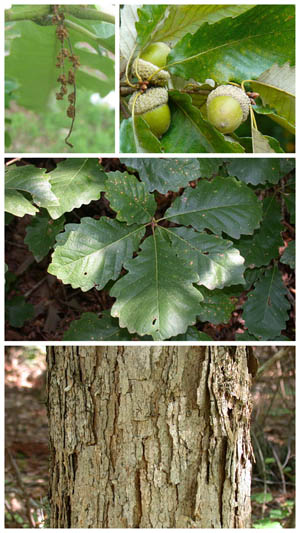
Swamp Chestnut
Quercus Michauxii
The Swamp chestnut oak, also called basket or cow oak, is a handsome member of the white oak group known for its large, fuzzy, coarsely-toothed leaves and big acorns. It is a large, deciduous tree that averages 60' to 80' in height with a 2' to 3' diameter. In rare cases, it may grow as tall as 120' with a 7' diameter. In open areas, the crown is low and widely spreading, but the tree has a more compact form when growing in a forest.
The thick, light gray bark is irregularly furrowed with long, narrow scales and shaggy rectangular plates. The leaves are simple, alternately arranged, 4" to 9" long, and 2 1/2" to 5" wide. They are obovate, broadest in the middle and above. The leaf base tapers and the leaf tip is rounded. The upper leaf surface is lustrous, dark green, and smooth while the underside is duller and fuzzy. Leaf margins are coarsely wavy-toothed. Leaves turn crimson in the fall.
The ovoid acorns are 1" to 1 1/2" long and light to dull brown. The bowl-like cap covers 1/3 to 1/2 of the acorn and has distinct, wedge-shaped, triangular scales. Acorns mature in one season and may grow singularly or in clusters of two or three. White-tailed deer, turkey, squirrels, and hogs eat the acorns. Cows also eat these acorns, as the common name 'cow oak' suggests.
The thick, light gray bark is irregularly furrowed with long, narrow scales and shaggy rectangular plates. The leaves are simple, alternately arranged, 4" to 9" long, and 2 1/2" to 5" wide. They are obovate, broadest in the middle and above. The leaf base tapers and the leaf tip is rounded. The upper leaf surface is lustrous, dark green, and smooth while the underside is duller and fuzzy. Leaf margins are coarsely wavy-toothed. Leaves turn crimson in the fall.
The ovoid acorns are 1" to 1 1/2" long and light to dull brown. The bowl-like cap covers 1/3 to 1/2 of the acorn and has distinct, wedge-shaped, triangular scales. Acorns mature in one season and may grow singularly or in clusters of two or three. White-tailed deer, turkey, squirrels, and hogs eat the acorns. Cows also eat these acorns, as the common name 'cow oak' suggests.
Sources:
- UF-SFRC : 4-H : Swamp chestnut oak. (2014, March 7). University of Florida - School of Forest Resources & Conservation. http://www.sfrc.ufl.edu/extension/4h/ecosystems/_plants/Swamp_chestnut_oak/index.html

White Oak
Quercus alba
White oak has a short stocky trunk with massive horizontal limbs. The wide-spreading branches form an upright, broad-rounded crown. The bark is light ashy gray, scaly, or shallow furrowed, often broken into small, narrow, rectangular blocks and scales. The leaves are dark green to slightly blue-green in summer, brown and wine-red to orange-red in the fall. The fall foliage is showy. Oaks are wind-pollinated. Acorns are produced generally when the trees are between 50-100 years old. Open-grown trees may produce acorns are early as 20 years. The white oak grows to a height of 50–80' and a spread of 50–80' at maturity, having the ability to live for centuries.
White oaks feature alternating leaves that are 4–8" long with 3–4 rounded, finger-like lobes on each side and one at the tip. This tree produces long, yellowish-green catkins drooping in clusters in the spring. It yields acorns that are up to 1" long with a warty cap that covers about ¼ of the nut. The acorns are one of the best sources of food for wildlife and are gathered, hoarded, and eaten by birds, hoofed browsers, and rodents. Leaf buds also are eaten by several bird species, and all parts of the tree are a favorite food for deer.
White oaks feature alternating leaves that are 4–8" long with 3–4 rounded, finger-like lobes on each side and one at the tip. This tree produces long, yellowish-green catkins drooping in clusters in the spring. It yields acorns that are up to 1" long with a warty cap that covers about ¼ of the nut. The acorns are one of the best sources of food for wildlife and are gathered, hoarded, and eaten by birds, hoofed browsers, and rodents. Leaf buds also are eaten by several bird species, and all parts of the tree are a favorite food for deer.
Sources:
- White Oak Tree on the Tree Guide at arborday.org. (n.d.). Arbor Day Foundation. Retrieved April 21, 2021, from https://www.arborday.org/trees/treeGuide/TreeDetail.cfm?itemID=883
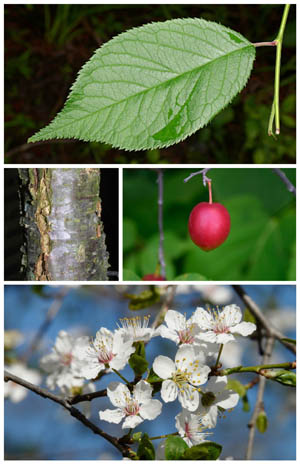
American Plum
Prunus americana
American Plum, also called Wild plum, is a small, fast-growing, short-lived, native tree, commonly found along fencerows, open fields, and roadsides. Abundant tiny white flowers open before the leaves emerge in spring. Plums appear in late summer.
Sources:
- "Wild Plum." The Morton Arboretum, The Morton Arboretum, 5 Mar. 2021 https://mortonarb.org/plant-and-protect/trees-and-plants/wild-plum/.
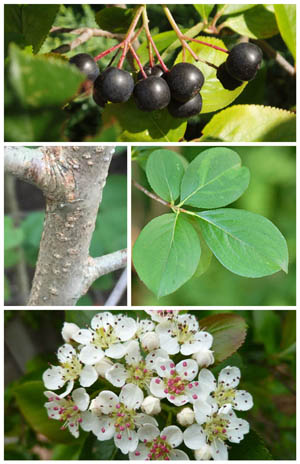
Black Chokeberry
Aronia melanocarpa
Black Chokeberry is a dependable small to medium sized shrub with an upright, mounded habit and can reach a height of 3 to 6 feet. Small clusters of white flowers in spring are followed by shiny black fruit. The dark green foliage turns reddish-purple in the fall. This plant is native to North America. It is native to low woods, swamps, bogs, and other moist areas but occasionally to dry areas. The common name of chokeberry is a reference to the tart and bitter taste of the fruits which are edible but so astringent as to cause choking in most of those who try. Fruits are sometimes used to make tasty jams and jellies.
Sources:
- "Aronia Melanocarpa." Aronia Melanocarpa - Plant Finder, Missouri Botanical Garden, https://www.missouribotanicalgarden.org/PlantFinder/PlantFinderDetails.aspx?taxonid=286429.
- "Black Chokeberry." The Morton Arboretum, 15 May 2021, https://mortonarb.org/plant-and-protect/trees-and-plants/black-chokeberry/#!.
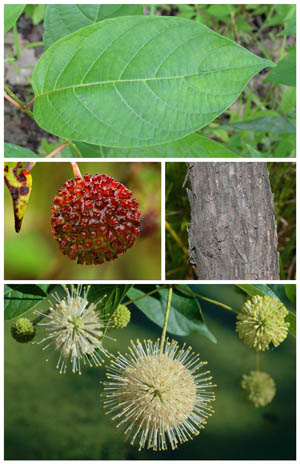
Buttonbush
Cephalanthus occidentalis
Buttonbush, also called button willow or honeyballs, is a species of shrubs or small trees that are native to Africa, Asia, and North America. Buttonbush plants are named for their fragrant creamy white spherical flowers. They are sometimes used in landscaping and are a source of food for ducks and other waterfowl. In North America, the common buttonbush is the best-known member of the genus and can reach up to 20 feet high in marshes and swamps.
Sources:
- "Buttonbush." Encyclopaedia Britannica, Encyclopaedia Britannica, Inc., https://www.britannica.com/plant/buttonbush.
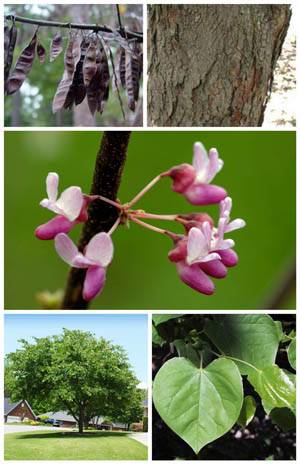
Eastern Redbud
Cercis canadensis
Eastern redbud is named for where it grows, in eastern North America, and the beautiful, reddish flower buds. Other names include Judas-tree. Eastern redbud’s native range is New Jersey to northern Florida, west to Missouri and Texas and northern Mexico. Eastern redbud is a small deciduous tree. Trees typically grow 20 feet in height with a similar spread and have ascending branches and a rounded shape. Eastern redbud leaves are 3 to 5 inches high and wide. Leaves begin reddish, turning green as they grow larger. Leaves are dark green in summer and then turn yellowish in autumn. The flowers are small and rose pink with a purplish tinge. Flowers develop before the leaves in spring, emerging in clusters along the branches. By mid-summer the flowers are replaced by bean-like seed pods that persist through the winter. Redbud flowers and young legumes are edible. The thin bark is gray and becomes scaly on older trees.
Sources:
- "Eastern Redbud, Cercis Canadensis." Bernheim Arboretum and Research Forest, https://bernheim.org/learn/trees-plants/bernheim-select-urban-trees/eastern-redbud/.
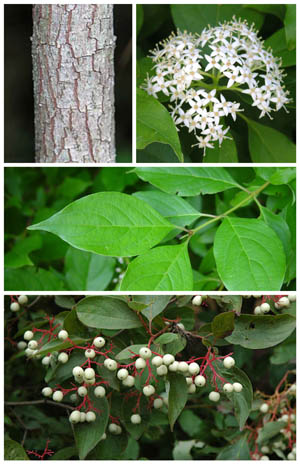
Gray Dogwood
Cornus racemose
Gray dogwood is a very adaptable, native shrub that is excellent for naturalizing, especially in difficult sites, such as pond and stream banks. Although its suckering and spreading habit makes it impractical for formal plantings, it can be incorporated into the shrub border and useful as a mass planting. Creamy white clusters of flowers in May are followed by white berries in late summer that are quickly eaten by birds.
Sources:
- The Morton Arboretum. (2021, May 13). Gray dogwood. The Morton Arboretum. Retrieved October 19, "Gray Dogwood." The Morton Arboretum, The Morton Arboretum, 13 May 2021, https://mortonarb.org/plant-and-protect/trees-and-plants/gray-dogwood/.
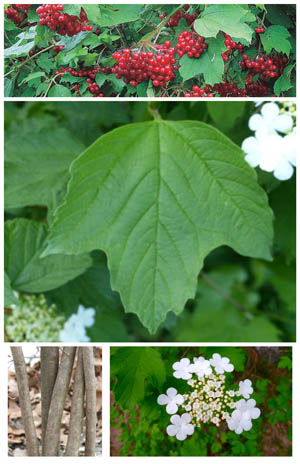
Highbush Cranberry
Viburnum opulus
Also known as European cranberry, or water elder, Highbush Cranberry is a small tree reaching 13 feet. It has three- to five-lobed, maplelike leaves and round heads of white flowers that are followed by hanging clusters of shiny, bright red, translucent berries. The leaves turn red in autumn.
Sources:
- "European Cranberry." Encyclopaedia Britannica, Encyclopaedia Britannica, Inc., https://www.britannica.com/plant/European-cranberry.
- "Viburnum." Encyclopaedia Britannica, Encyclopaedia Britannica, Inc., https://www.britannica.com/plant/viburnum#ref119544.
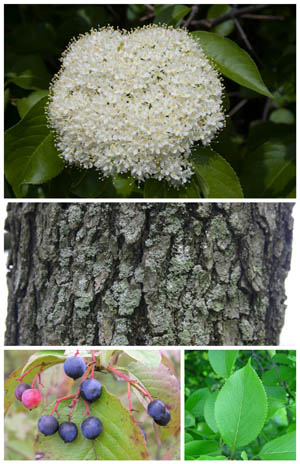
Nannyberry
Viburnum lentago
Nannyberry grows as a large shrub or a small tree reaching 15 to 50 feet high, and is for possessing dark, lustrous green leaves which turn dark red in the fall. Typically found in woodlands and wood edges, Nannyberry is a great plant for naturalizing. Nannyberry tends to grow in thickets.
Sources:
- "Nannyberry." The Morton Arboretum, The Morton Arboretum, 27 May 2021, https://mortonarb.org/plant-and-protect/trees-and-plants/nannyberry/.

Ninebark
Physocarpus opulifolius
Ninebark is a cold hardy, tough, native shrub for mixed borders. Pinkish-white flower clusters in late spring, persistent seed capsules and exfoliating bark adds to the seasonal interest. Foliage of cultivars varies in size and color from purple to lime green.
Sources:
- “Common Ninebark.†The Morton Arboretum, The Morton Arboretum, 28 May 2021, https://mortonarb.org/plant-and-protect/trees-and-plants/common-ninebark/.
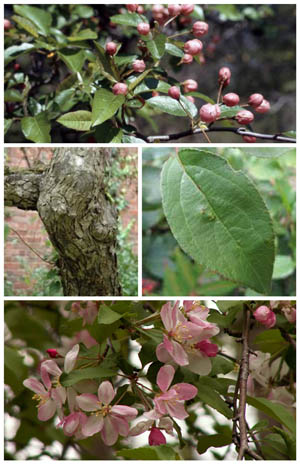
Sweet American Crabapple
Malus coronaria
Sweet American Crabapple is a native small tree in the rose family. It grows 15 to 30 feet tall with a broad open crown. It prefers a sunny spot with moist loamy soil but will tolerate part shade. In its southern range, it is usually found in the mountains. In spring it is covered in fragrant pink flowers. The fruits are small and bitter but can be used for making preserves or cider. Wildlife uses this tree as a food source, cover and nesting site.
Sources:
- "Malus Coronaria." Malus Coronaria (American Crabapple, Garland Crab, Sweet Crabapple, Wild Crabapple) | North Carolina Extension Gardener Plant Toolbox, NC State Extension, https://plants.ces.ncsu.edu/plants/malus-coronaria/.
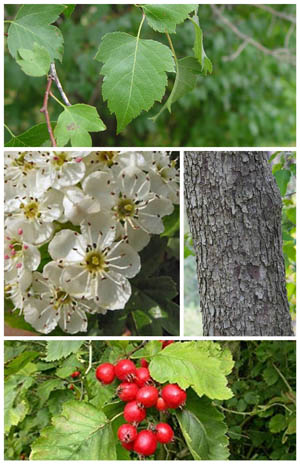
Washington Hawthorn
Crataegus phaenopyrum
The Washington hawthorn is famous for its red autumn color and its large numbers of orange-red fruit clusters that remain on the twigs well into winter. Hawthorns are decidious plants with simple leaves that are usually toothed or lobed. The white or pink flowers, usually in clusters, are followed by small apple-like fruits that range from red to orange to blue or black. The fruits vary in taste and texture but are edible and sometimes used in herbal medicine.
Sources:
- "Hawthorn." Encyclopaedia Britannica, Encyclopaedia Britannica, Inc., https://www.britannica.com/plant/hawthorn#ref72570.
- "Washington Hawthorn." Encyclopaedia Britannica, Encyclopaedia Britannica, Inc., https://www.britannica.com/plant/Washington-hawthorn.
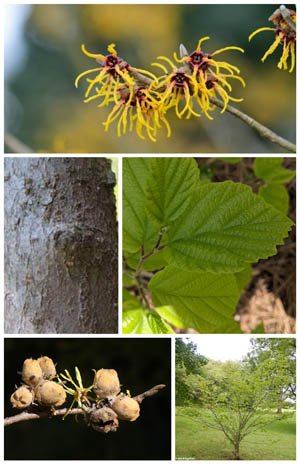
Witch Hazel
Hamamelis virginiana
The yellow, strap-like flowers of this native shrub are among the last blooms to appear in fall but are often hidden by the leaves. Common witch-hazel is a large shrub with a picturesque irregular branching habit that naturally grows along woodland edges. The large, rounded, dark green leaves often hang onto the winter branches. The fruit capsules mature a year after flowering, splitting open to expel seeds that are attractive to birds.
Sources:
- "Common Witch-Hazel." The Morton Arboretum, The Morton Arboretum, 12 Mar. 2021, https://mortonarb.org/plant-and-protect/trees-and-plants/common-witch-hazel/.
